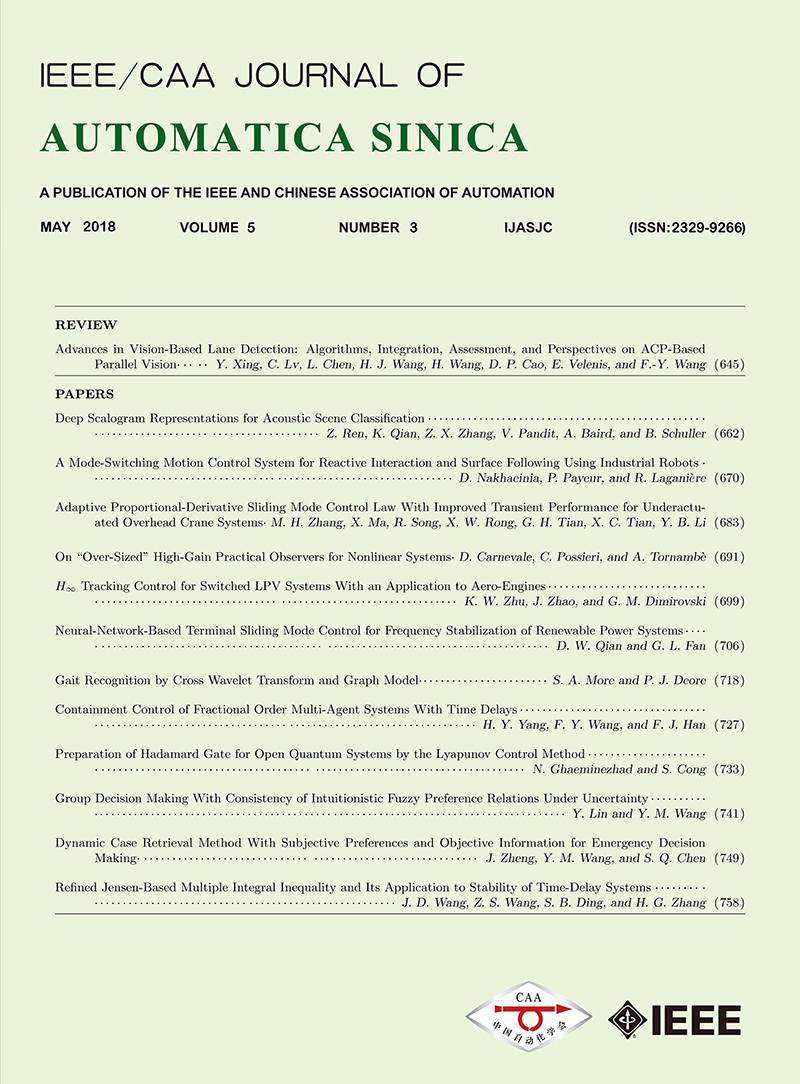 Volume 1
Issue 4
Volume 1
Issue 4
IEEE/CAA Journal of Automatica Sinica
| Citation: | Manoj Kumar, Karthikeyan Rajagopal, Sivasubramanya Nadar Balakrishnan and Nhan T. Nguyen, "Reinforcement Learning Based Controller Synthesis for Flexible Aircraft Wings," IEEE/CAA J. of Autom. Sinica, vol. 1, no. 4, pp. 435-448, 2014. |

| [1] |
Lasiecka I. Control of systems governed by partial differential equations:a historical perspective. In: Proceedings of the 34th Conference onDecision and Control. New Orleans, LA: IEEE, 1995. 2792-2796
|
| [2] |
Burns J A, King B B. Optimal sensor location for robust control ofdistributed parameter systems. In: Proceedings of the 1994 Conferenceon Decision and Control. Lake Buena Vista, FL, USA: IEEE, 1994.3967-3972
|
| [3] |
Curtain R F, Zwart H J. An introduction to Infinite Dimensional LinearSystems Theory. New York: Springer-Verlag, 1995.
|
| [4] |
Padhi R, Balakrishnan S N. Optimal dynamic inversion control designfor a class of nonlinear distributed parameter systems with continuousand discrete actuators. The Institute of Engineering and Technology,Control Theory, and Applications, 2007, 1(6): 1662-2671
|
| [5] |
Haykin S. Neural Networks. New York: Macmillan College Company,1994.
|
| [6] |
Gupta S K. Numerical Methods for Engineers. New Delhi: New AgeInternational Ltd., 1995.
|
| [7] |
Christofides P D. Nonlinear and Robust Control of PDE Systems:Methods and Applications to Transport-Reaction Processes. Boston:Birkhauser Boston Inc., 2001.
|
| [8] |
Holmes P, Lumley J L, Berkooz G. Turbulence Coherent Structures,Dynamical Systems and Symmetry. Cambridge: Cambridge UniversityPress, 1996. 87-154
|
| [9] |
Bryson A E, Ho Y C. Applied Optimal Control: Optimization, Estimation,and Control. Washington: Taylor and Francis, 1975
|
| [10] |
Lewis F. Applied Optimal Control and Estimation. New Jersey: Prentice-Hall, 1992.
|
| [11] |
Werbos P J. Neurocontrol and supervised learning: an overview andevaluation. Handbook of Intelligent Control: Neural, Fuzzy and AdaptiveApproaches. New York: Van Nostrand Reinhold, 1992
|
| [12] |
Balakrishnan S N, Biega V. Adaptive-critic based neural networks foraircraft optimal control. Journal of Guidance, Control and Dynamics,1996, 19(4): 893-898
|
| [13] |
Padhi R, Unnikrishnan N, Wang X, Balakrishnan S N. A single networkadaptive critic (SNAC) architecture for optimal control synthesis for aclass of nonlinear systems. Neural Networks, 2006, 19: 1648-1660
|
| [14] |
Padhi R, Balakrishnan S N. Optimal beaver population managementusing reduced-order distributed parameter model and single networkadaptive critics. In: Proceedings of the 2004 American Control Conference.Boston, MA, 2004. 1598-1603
|
| [15] |
Yadav V, Padhi R, Balakrishnan S N. Robust/optimal temperature profilecontrol of a re-entry vehicle using neural networks. In: Proceedings ofthe 2006 AIAA Atmospheric Flight Mechanics Conference and Exhibit.Keystone, Colorado: AIAA, 2006. 21-24
|
| [16] |
Prabhat P, Balakrishnan S N, Look D C Jr. Experimental implementationof adaptive-critic based infinite time optimal neurocontrol for aheat diffusion system. In: Proceedings of the 2002 American ControlConference. Alaska, USA: IEEE, 2002. 2671-2676
|
| [17] |
Chakravarthy A, Evans K A, Evers J. Sensitivity & functional gains fora flexible aircraft-inspired model. In: Proceedings of the 2011 AmericanControl Conference. Baltimore, MD, USA: IEEE, 2010. 4893-4898
|
| [18] |
Chakravarthy A, Evans K A, Evers J, Kuhn L M. Target tracking strategiesfor a nonlinear, flexible aircraft-inspired model. In: Proceedings ofthe 2011 American Control Conference. San Francisco: IEEE, 2011.1783-1788
|
| [19] |
Narendra K S, Annaswamy A M. Stable Adaptive Systems. EnglewoodCliffs, NJ: Prentice-Hall, 1989.
|
| [20] |
Ioannou P A, Sun J. Robust Adaptive Control. Englewood Cliffs, NJ:Prentice-Hall, 1995.
|
| [21] |
Böhm M, Demetriou M A, Reich S, Rosen I G. Model reference adaptivecontrol of distributed parameter systems. SIAM Journal of Control andOptimization, 1998, 36(1): 33-81
|
| [22] |
Hong K S, Bentsman J. Direct adaptive control of parabolic systems:algorithm synthesis and convergence and stability analysis. IEEE Transactionsof Automatic Control, 1994, 39(10): 2018-2033
|
| [23] |
Hong K S, Yang K J, Kang D H. Model reference adaptive control of atime-varying parabolic system.KSME International Journal, 2000, 14(2):168-176
|
| [24] |
Krstic M, Smyshlyaev A. Adaptive control of PDEs. Annual Reviews inControl, 2008, 32(2): 149-160
|
| [25] |
Demetriou A M, Rosen I G. On-line robust parameter identification forparabolic systems. International Journal of Adaptive Control and SignalProcessing, 15(6): 615-631
|
| [26] |
Sirovich L. Turbulence and the dynamics of coherent structures. Quarterlyof Applied Mathematics, 1987, 45(3): 561-590
|
| [27] |
Ravindran S S. Proper Orthogonal Decomposition in Optimal Controlof Fluids, NASA/TM-1999-209113. USA, 1999.
|
| [28] |
Padhi R, Balakrishnan S N. Proper orthogonal decomposition basedoptimal control design of heat equation with discrete actuators usingneural networks. American Control Conference, ACC02-IEEE 1545,2002.
|
| [29] |
Padhi R, Balakrishnan S N. Proper orthogonal decomposition basedfeedback optimal control synthesis of distributed parameter systemsusing neural networks. In: Proceedings of the 15th American ControlConference. Anchorage, AK: IEEE, 2002. 4389-4394
|
| [30] |
Ravindran S S. Adaptive reduced-order controllers for a thermal flowsystem using proper orthogonal decomposition. SIAM Journal on ScientificComputing, 2002, 23(6): 1924-1942
|
| [31] |
Popov V M. Hyperstability of Control Systems. Berlin: Springer, 1973.
|
| [32] |
Olver P J. Introduction to Partial Differential Equations. New York:Springer-Verlag, 2013.
|